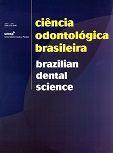Avaliação do sistema Quantec SC usado nas velocidades de 350 ou 700rpm em retratamento endodôntico
DOI:
https://doi.org/10.14295/bds.2009.v12i3.630Abstract
O objetivo deste estudo foi analisar a capacidade do sistema rotatório Quantec SC de remover guta-percha e/ou cimento de canais quando usado na velocidade de 350 ou 700rpm. Vinte incisivos inferiores extraídos foram obturados pela técnica da condensação lateral com guta-percha e cimento Ketac-Endo. Após seis meses as obturações foram removidas com o sistema rotatório Quantec SC na velocidade de 350 ou 700rpm. Inicialmente foram avaliados o tempo para a remoção da obturação, a extrusão de material obturador bem como o desvio do trajeto do canal, perfuração e a fratura de instrumento. A seguir os dentes foram seccionados longitudinalmente e a limpeza das paredes dos canais foi avaliada usando o software Sigma Scan. Aos dados obtidos foi aplicado o teste estatístico de Kruskal-Wallis. Observou-se que todos os canais exibiram resíduos de material obturador; a 700rpm o tempo de remoção da obturação foi menor, porém, a 350rpm menor quantidade de resíduos de guta-percha e cimento foram observadas. Quanto a extrusão de material obturador, não foram observadas diferenças estatísticas entre as velocidades de 350 e 700rpm. Fraturas de instrumento ocorreram em ambas as velocidades sendo mais freqüentes no instrumento nº5; o número de perfurações e desvios do trajeto do canal foi maior na velocidade de 350rpm. Conclui-se que os instrumentos rotatórios do sistema Quantec SC podem ser utilizados para desobstrução de canais na velocidade de 700rpm.
Downloads
Downloads
Published
How to Cite
Issue
Section
License
Brazilian Dental Science uses the Creative Commons (CC-BY 4.0) license, thus preserving the integrity of articles in an open access environment. The journal allows the author to retain publishing rights without restrictions.
=================




























